https://doi.org/10.59793/ijcp.v34i4.595
Abstract
Background: Enzymes are crucial for proper bodily functions, but as individuals age or experience medical conditions, their levels decrease, leading to several health issues most common being the gastrointestinal (GI) problems like dyspepsia, constipation and irritable bowel syndrome (IBS). The study assessed age-related enzyme deficiency in the Indian population and investigated the effectiveness of a combined supplementation of alpha-amylase and papain enzymes. Methods: The study was a retrospective study in July 2023 used a questionnaire-based survey to assess the prevalence of age-related enzyme deficiency in Indian population and the efficacy of supplementing with a combination of alpha-amylase and papain enzyme in this population. The study used a validated questionnaire with 18 questions, and data was entered into a software database. Complete cases were analyzed, and missing data was excluded due to low occurrence. The final report was prepared after cleaning the data. Result: The study included 134 doctors from various medical specializations. Results showed that the majority of doctors were GI specialists, with the highest frequency of patients with age-related enzyme deficits in the 40 to
60 years age groups (55.2%). The combination of alpha-amylase and papain was found to relieve proton pump inhibitor (PPI) overuse adverse effects. The safety profile was neutral (64.9%), with 30.6% stating it as safe and 2.2% as very safe. The combination was found to be neutral (48.5%), effective (45.5%) and very effective (3.7%), with age-related considerations being the main factor. Most doctors rated the combination as neutral (64.9%), with 29.1% giving a good rating and 5.2% giving a very good rating. Conclusion: In conclusion, this study sheds light on the prevalence of age-related enzyme deficiency in the Indian population and provides evidence for the potential efficacy of a combined alpha-amylase and papain enzyme supplement in addressing these deficiencies.
Keywords: Age-related enzyme deficiency, Indian population, efficacy, alpha-amylase, papain enzyme
Human aging occurs gradually over the years, and understanding age-related health concerns is crucial. Enzymes are essential for various physiological functions, such as digestion and food absorption. With age, enzyme aiding in these important physiological processes also decline. In India, people retire from work at age 60, marking the beginning of lesser physical activities and a more sedentary lifestyle, which in turn triggers age-related health issues.1
Aging is inversely correlated with increased physiological and organ-specific health issues, particularly noncommunicable ones. About 25% of patients have cardiovascular disease, while 20% have general colds, coughs, fever and gastrointestinal (GI) disturbances.2
Enzymes are crucial for the efficient functioning of the digestive, neurological and muscular systems.3,4 However, some individuals low levels of digestive enzymes or experience improper enzyme release, leading to functional GI disorders such as constipation, dyspepsia and irritable bowel syndrome (IBS).5-7 This has led to the overuse of proton pump inhibitors (PPIs), which increase the risk of infections, bone fractures and renal damage.8,9
Enzyme supplements therapy may be beneficial for these malabsorption of nutrients and GI infections, providing relief from acid reflux, gas, bloating and diarrhea while also assisting the body's digestion and nutrient absorption.9
Amylase, protease, lactase, lipase, diastase and papain are important digestive enzymes. Several instances have been reported in which the administration of enzymes has proved effective.
Amylase, a crucial enzyme for metabolizing starch produced in the pancreas and saliva, speeds up the digestion process and helps relieve from constipation and other GI diseases.10 Amylases break down starch into smaller molecules, producing maltose, which is then broken down by maltase into two molecules of glucose. To continue breaking down the incoming starch, a lot of pancreatic amylase is delivered into the duodenum via the pancreatic duct.11
It can be elevated in pancreatic illness, salivary disease, reduced metabolic clearance, intestinal disease, macroamylasemia and lowered in disorders such as pancreatic damage, injury, nephropathy, pregnant toxemia and pancreatic cancer.12,13
Papain is one of the best and most potent digestive enzymes, helping to break down even the most resistant protein fibers and relieve IBS symptoms, reducing inflammation and expediting healing following surgery. The declining levels of the digestive systems reduce digestive efficiency, leading to various health problems.14
Functional dyspepsia (indigestion) is typically treated with medications that reduce the production of acid, such as PPIs and H2-receptor antagonists. Long-term use of PPIs increases the risk of dementia, enteroendocrine tumors of the digestive tract, kidney, liver and cardiovascular disease, as well as the susceptibility to respiratory and GI infections and decreased nutrient absorption.15,16
Postprandial digestive symptoms such as diarrhea, abdominal distension, flatulence, bloating and fullness sensation are frequent complaints with unidentified etiology and pathophysiology. Numerous studies have documented the beneficial effects of products containing various combinations of digestive enzymes.17
Ayurvedic medicine favors the use of papaya fruit containing papain as digestives and stomachics and its latex to relieve from dyspepsia. Papain preparation significantly reduced constipation, painful, difficult stool motions and flatulence in 139 volunteers with functional GI complaints compared to placebo.18
This study aims to determine the prevalence of age-related enzyme deficiency in the Indian population and evaluate the efficacy of alpha-amylase and papain enzyme supplementation in treating GI disorders. It also explores physicians' opinions and experiences regarding the combination of alpha-amylase and papain enzyme in treating these disorders.
METHODS
Study Design and Setting
The study was a retrospective study conducted via a questionnaire-based survey among all doctors in July 2023. It is a mixed-method study to assess the prevalence of age-related enzyme deficiency in Indian population and the efficacy of supplementing with a combination of alpha-amylase and papain enzyme in this population.
Study Population
All qualified doctors (General Physicians, Consulting Physicians, Dietician, Gastroenterologists, Endocrinologists, etc.) practicing modern medicine were eligible for the survey and were approached to participate. The survey intended to include doctors across all clinical departments, work experience and professional hierarchy. In this study, 134 Indian doctors participated in the questionnaire survey on use of the prevalence of age-related enzyme deficiency in Indian population and the efficacy of supplementing with a combination of alpha-amylase and papain enzyme in this population.
Data Collection
The survey tool was a validated questionnaire containing 18 questions. It was in the form of a closed-ended questionnaire, was developed by an expert panel comprising a physician, and a pharmacologist. The questionnaire was specifically focused on the study aims and tailored contextually to fit local situations.
All filled forms were entered into the software database. For discrepancies related to data entry alternate forms were physically cross-checked. Complete cases were analyzed and missing data were not included because of low occurrence. The data were analyzed after cleaning the data and final report was prepared.
RESULTS
A total of 134 doctors from different medical specialization participated in the study with an aim to assess age-related enzyme deficiency in the Indian population and investigate the effectiveness of a combined supplementation of alpha-amylase and papain enzymes. Approximately 54.5% of them were Gastroenterologists, followed by General Physician (38.1%) and the rest together made up 7.4% (Fig. 1).
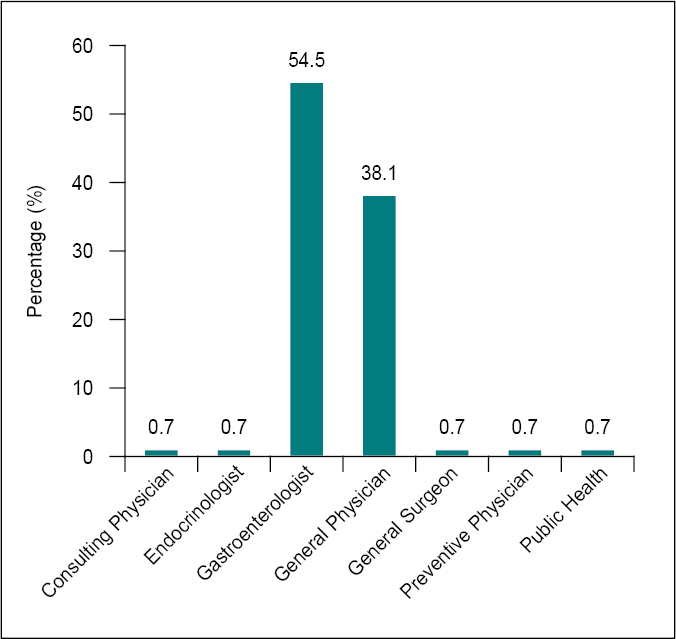
Figure 1. Percentage of doctors from different medical specialization participating in the study.
The doctors reported that the percentage of frequency of patients who came with age-related enzyme deficits sometimes was the highest (55.2%) (Fig. 2) and was most prominent (69.4%) in the age group 40 to 60 years, followed by people who were 60 years and above (29.9%) as seen in Figure 3.

Figure 2. Frequency of patients with age-related enzyme deficits reporting to doctors.

Figure 3. Age group of patients having prevalent digestive problems.
As the Figure 4 depicts, 48.5% doctors were moderately familiar with the combination of alpha-amylase and papain as a treatment option for dyspepsia, functional GI disorders or age-related disorders, followed by 23.9% doctors who were somewhat familiar and 23.1% doctors who were very well familiar with the benefits of the combination.

Figure 4. Familiarity with the combination of alpha-amylase and papain as a treatment option for dyspepsia, functional GI disorders or age-related disorders.
Nearly 83.6% of doctors agreed with the fact that combination of alpha-amylase and papain can be helpful in relieving PPI overuse adverse effects such as GI disorders and malabsorption of several nutrients compared to 16.4% doctors who did not as visible from the graph in Figure 5.
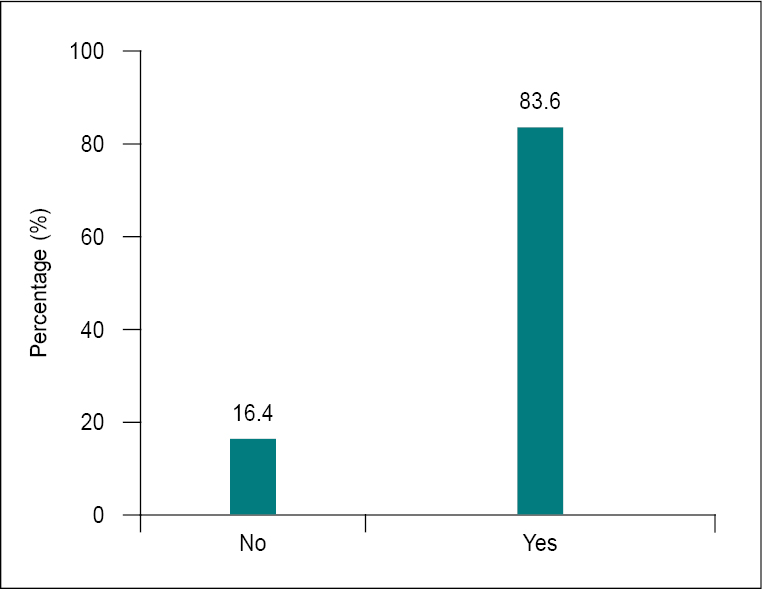
Figure 5. Usefulness of alpha-amylase and papain combination in relieving PPI overuse adverse effects.
Figure 6 shows that majority of doctors prescribing the combination of alpha-amylase and papain was moderately often (57.5%), followed by prescribing frequently (17.9%), then occasionally (14.2%).
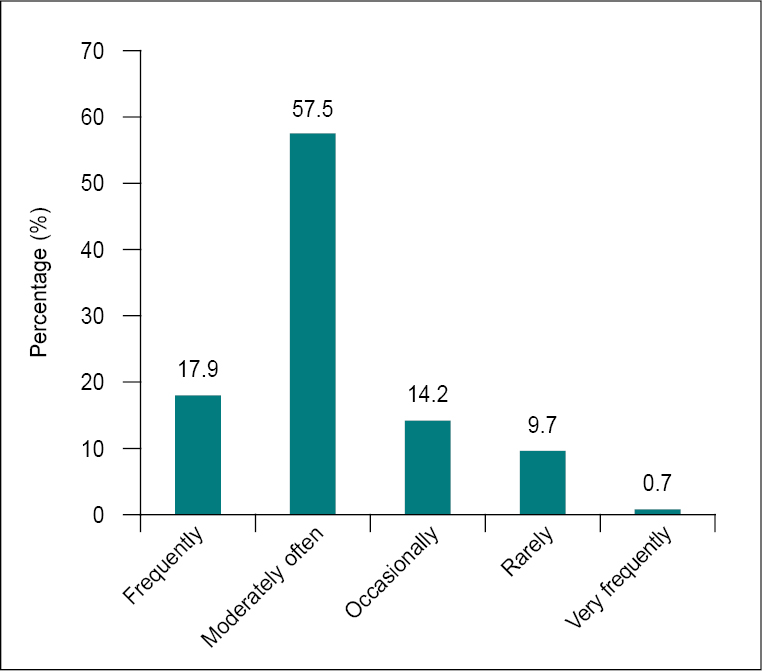
Figure 6. Frequency of prescribing the combination of alpha-amylase and papain.
As observed in Figure 7, patient preferences is the most important factor (53.7%), followed by efficacy (24.65%), cost-effectiveness (12.75) and safety profile (8.2%) being the other factors influencing the doctors decision to prescribe the combination of alpha-amylase and papain.
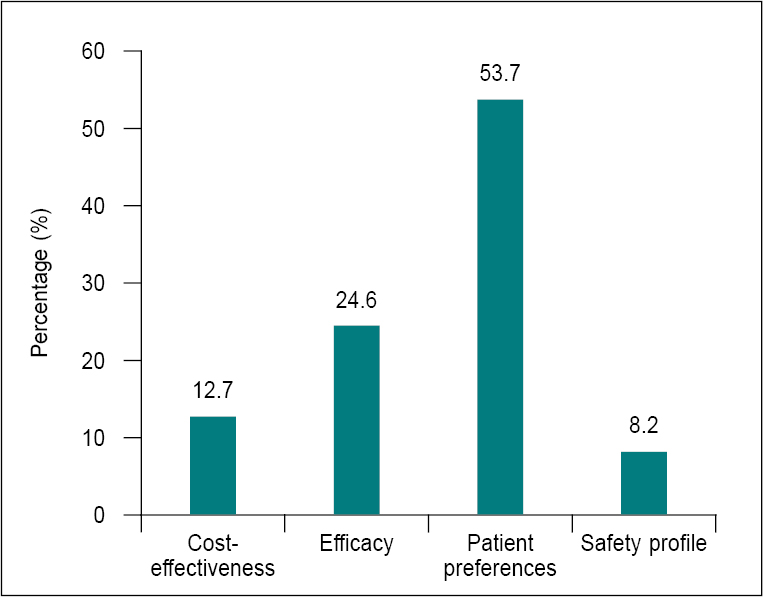
Figure 7. Factors influencing prescribing the combination of alpha-amylase and papain over other treatment options.
Safety profile was found to be neutral (64.9%) as agreed by majority of doctors, followed by 30.6% stating it as safe and 2.2% agreeing that the combination was very safe. Only 1.5% doctors had the view that it was unsafe as shown in Figure 8.
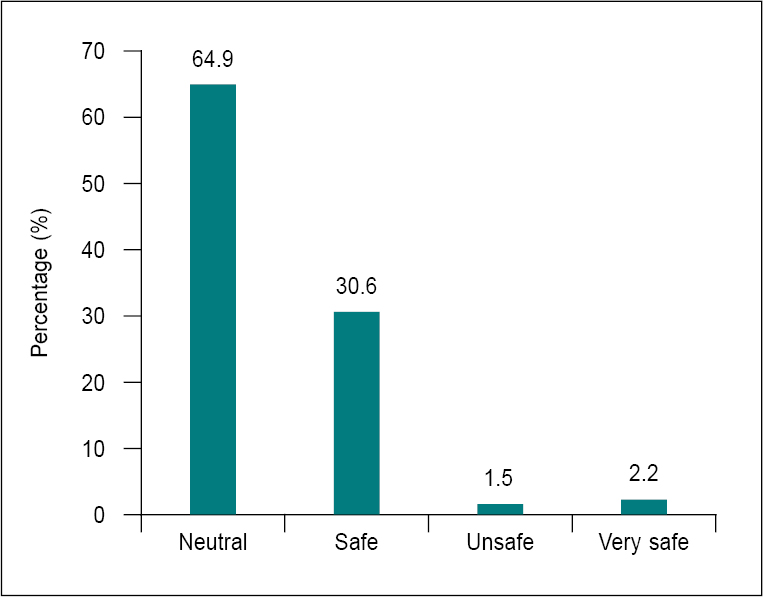
Figure 8. Safety profile of the combination of alpha-amylase and papain.
Majority of the doctors (98.5%) said that they did not encounter any adverse events or side effects in patients who were prescribed the combination of alpha-amylase and papain, as is evident in Figure 9. Only 1.5% stated that they had observed some minor side effects such as spasmodic pain as reported by some doctors.

Figure 9. Response-related to encountering any adverse side effects.
The effectiveness of the combination of alpha-amylase and papain was shown in Figure 10. Mostly it was found to be neutral (48.5%), followed by effective (45.5%), then very effective (3.7%), while only 1.5% agreed that the combination had no effect.

Figure 10. Efficacy of the combination of alpha-amylase and papain.
The study in Figure 11 also showed that majority of doctors (46.3%) agreed that the effectiveness of the combination of alpha-amylase and papain compared to other combinations was equally effective, while 44.8% were not sure of the effectiveness compared to other combinations.

Figure 11. Effectiveness of the combination of alpha-amylase and papain compared to other combinations.
Figure 12 shows the suitability of the alpha-amylase and papain in elderly. It was seen that though 68.7% were not sure about the suitability in elderly 24.6% doctors agreed that the combination was helpful in elderly.

Figure 12. Suitability in the elderly population.
The study also highlighted the fact that age-related considerations were the main factor (59.7%), which the doctors considered when determining the chronic usage of the combination of alpha-amylase and papain in elderly patients, followed by patient compliance (28.4%) as shown in Figure 13.

Figure 13. Factors determining the chronic usage.
The majority of doctors rated the combination as neutral (64.9%), while 29.1% gave a good rating with 5.2% giving a very good rating for the combination of alpha-amylase and papain as a treatment option for dyspepsia, functional GI disorders or age-related disorders as is evident in Figure 14.

Figure 14. Rating the combination of alpha-amylase and papain.
Figure 15 showed the satisfaction level with the combination. Nearly 67.9% were moderately satisfied, while 30.6% were extremely satisfied.

Figure 15. Satisfaction levels of doctor with the combination.
Ninety-four percent of doctors agreed that they would suggest combination of alpha-amylase and papain to their co-workers or other medical professionals as a supplement for age-related enzyme deficiencies as is seen in Figure 16.

Figure 16. Percentage of doctors agreed to prescribe the alpha-amylase and papain combination to co-workers.
Finally, 94.8% doctors agreed that the combination of alpha-amylase and papain aids faster recovery and overall well-being as is observed in Figure 17.

Figure 17. Percentage of doctor agreeing with the fact that the combination of alpha-amylase and papain aids faster recovery and overall well-being.
DISCUSSION
The effectiveness of the digestive systems is reduced as we age, which causes a number of health issues. By the age of 40, the enzyme level in the digestive system may be around 25% lower, and by the ages of 60 or 70, it might be significantly lower. Basic functional GI illnesses like IBS, functional dyspepsia or functional constipation, among others, rise as a result of these declining enzyme levels.19
Mostly, it has been observed that patients visit Gastroenterologists due to unexplained abdominal pain.20 The current study shows that 54.5% of the medical professionals participating in the study were Gastroenterologists showing that in the real-world scenario also patients mostly visit the Gastroenterologists, followed by General Physician (38.1%) and the rest together made up 7.4% (Fig. 1).
The prevalence of digestive problems (gastroesophageal reflux disease [GERD]) in large population-based studies in India is approximately 10% and is probably increasing due to lifestyle changes and altered eating habits and aging. Hence, the burden on Gastroenterologists and proper medication to treat these digestive problems is also increasing.20
Figure 2 demonstrates that the percentage of frequency of patients who came to doctors with age-related enzyme deficits. It was the highest (55.2%) in the sometimes or occasionally visits with the predominance (69.4%) in the age group 40 to 60 years, followed by people who were 60 years and above (29.9%) as seen in Figure 3.
Literature shows that aging has an impact on all gastrointestinal system (GIS) processes, including motility, enzyme and hormone production, digesting and absorption. The GIS is frequently impacted by side effects and is also crucial for the metabolism and absorption of medications.21
Digestion enzymes are heavily taxed by the traditional Indian diet, which is frequently abundant in complex carbohydrates and protein-rich meals. In India, the prevalence of GERD varies from 7.6% to 30%; it is often less than 10% in population studies and higher in cohort studies.22
Common complaints of sometimes unidentified etiology and pathophysiology include postprandial GI symptoms such diarrhea, abdominal distension, flatulence, bloating and a sense of fullness.17,23
In the present study, Figure 4 shows that the 48.5% doctors were moderately familiar, 23.9% doctors were somewhat familiar and 23.1% doctors who were very well familiar with the benefits of the combination of alpha-amylase and papain as a treatment option for dyspepsia, functional GI disorders or age-related disorders.
The calcium metalloenzyme alpha-amylase facilitates digestion by dissolving larger polysaccharide molecules into smaller ones like glucose and maltose.24 The enzyme breaks down or digests proteins, lipids and carbohydrates and aid in treating indigestion and stomach discomfort.
A study by Majeed et al (2018) supported the clinical evidence related to the safety and efficacy of multienzyme complex as a dietary supplement in the management of dyspeptic symptoms in patients with functional dyspepsia characterized by bloating, early satiety, postprandial fullness, nausea, anorexia and heartburn, regurgitation and burping.19
One of the strongest digestive enzymes, papain helps to break down even the most resistant protein fibers and can aid with IBS symptoms, inflammation reduction and postoperative recovery.
Newer studies have shown that enzyme supplementation therapy may play an important role in several digestive and malabsorption disorders. Combination of different enzymes might constitute an intriguing therapeutic option in the future.9
Nearly 83.6% of doctors agreed with the fact that combination of alpha-amylase and papain can be helpful in relieving PPI overuse adverse effects such as GI disorders and malabsorption of several nutrients compared to 16.4% doctors who did not as visible from the graph in Figure 5.
PPI are now being used excessively and inappropriately. The likelihood of abuse and misuse has grown enormously in India where there are over 500 branded formulations of PPI accessible. Many a times, PPIs don't work well for many people. In such a situation, both the patients and the medical professionals’ looks for some effective alternative with better effectiveness and safety profile.25
As observed in Figure 7, patient preferences is the most important factor (53.7%), followed by efficacy (24.65%), cost-effectiveness (12.75%) and safety profile (8.2%) being the other factors influencing the doctors decision to prescribe the combination of alpha-amylase and papain. Safety profile was found to be neutral (64.9%) as agreed by majority of doctors, followed by 30.6% stating it as safe and 2.2% agreeing that the combination was very safe. Only 1.5% doctors had the view that it was unsafe as shown in Figure 8.
Majority of the doctors (98.5%) said that they did not encounter any adverse events or side effects in patients who were prescribed the combination of alpha-amylase and papain, as is evident in Figure 9.
The effectiveness of the combination of alpha-amylase and papain was shown in Figure 10. Mostly, it was found to be neutral (48.5%), followed by effective (45.5%), then very effective (3.7%), while only 1.5% agreed that the combination had no effect. Figure 11 also showed that majority of doctors (46.3%) agreed that the effectiveness of the combination of alpha-amylase and papain compared to other combinations was equally effective.
A recent Indian post-marketing survey that included 2,125 individuals with functional dyspepsia showed that approximately 87% of patients who were treated for functional dyspepsia reported better symptoms after taking a multienzyme cocktail including amylase. At day 14, the average percentage of dyspepsia sufferers decreased from 66% at baseline to 8%, the condition's severity decreased from 0.95 to 0.09, and the feeling of fullness decreased from 63% to 7%.26
According to the present study, only 1.5% stated that they had observed some minor side effects such as spasmodic pain. Similarly, very insignificant or no side effects were seen in a multicenter, randomized, placebo-controlled crossover study by Ran et al (2009). The study involving 151 dyspeptic patients showed significant reductions in symptoms such as an epithymia, abdominal distension, belching, diarrhea, abdominal pain and epigastric burning after being treated with a combination of pancreatin and Aspergillus oryzae enzyme extract (amylase).27
Study by Muss et al showed significant reduction in constipation, painful, difficult stool motions and flatulence in 139 volunteers with functional GI complaints after being treated with papain preparation compared to placebo.18
Another study showed that papain decreased stomach inflammation in a clinical investigation involving 200 participants who had dyspepsia. It reduced symptoms including heartburn, nausea, vomiting, burping and bloating as compared to the placebo.28
A recent study by Annaházi et al (2021) examined the effects of papain on guinea pig corpus and antrum strips. Papain increased the antrum's ongoing phasic contractions, but the muscle tone and frequency stayed the same. It caused the corpus to constrict for a brief period of time while before relaxing for a considerable period of time. Hence, it is hypothesized that papain-like cysteine proteases may also have a direct impact on the GI muscles, potentially alleviating IBS symptoms.29
Postprandial digestive symptoms as diarrhea, abdominal distension, flatulence, bloating and a fullness sensation are frequent complaints with frequently unidentified etiology and pathophysiology. Numerous studies, including a number of randomized placebo-controlled trials, have documented the beneficial effects of products containing various combinations of digestive enzymes.17
Figure 12 shows the suitability of the alpha-amylase and papain in elderly. It was seen that though 68.7% were not sure about the suitability in elderly, 24.6% doctors agreed that the combination was helpful in elderly. The study also highlighted the fact that age-related considerations were the main factor (59.7%) which the doctors considered when determining the chronic usage of the combination of alpha-amylase and papain in elderly patients, followed by patient compliance (28.4%) as shown in Figure 13.
Functional dyspepsia is found to be one of the most common conditions in elderly worldwide. According to a Korean study, functional dyspepsia is more common in those under 60 years old (11% vs. 10% of people up to that age) in Asia.30 Digestive enzymes including amylase, protease and lipase are produced and secreted by the GI system. These enzymes aid in digestion by facilitating the break down of larger molecules contained in food such as carbohydrates, proteins and lipids. It is also believed that a lack of digestive enzymes is one of the contributing reasons of functional dyspepsia, even if the potential relevance of enzyme deficit in the etiopathogenesis of functional dyspepsia is yet unclear. However, studies have shown that providing functional dyspepsia patients with multienzyme formulations may help to minimize their postprandial discomfort and symptoms of gas, bloating, belching and fullness.19
The findings revealed a notable prevalence of age-related enzyme deficiency, particularly among older individuals. Preliminary results from this study are promising, suggesting that enzyme supplementation could lead to improved digestive function and nutrient absorption among the target population.
IMPLICATIONS AND LIMITATIONS
The questionnaire-based survey offers valuable insights for health care professionals in India to better understand age-related enzyme deficiencies. While the study results could lead to personalized dietary recommendations for the Indian population, especially older individuals. Incorporating alpha-amylase and papain enzyme supplements could potentially enhance digestion and mitigate related health issues but still, it is essential to acknowledge its limitations.
The survey's reliability may be affected by sampling bias, as only physicians who agreed to participate share their views on age-related enzyme deficiency in the Indian population. The study's duration may challenge evaluating long-term effects or adverse consequences. Response bias may arise from subjective responses, and low response rates raise concerns about nonresponse bias. Mitigating these limitations and implementing mitigation strategies can maximize the survey's reliability and credibility.
CONCLUSION
To conclude, the study shows a significant prevalence of age-related enzyme deficiency in the Indian population, particularly among older individuals. The retrospective study conducted via a questionnaire-based survey suggests supplementation with alpha-amylase and papain enzymes could enhance digestive function, nutrient absorption and are effective and safe to maintain the overall health outcomes, especially among elderly.
REFERENCES
- Kaczor JJ, Ziolkowski W, Antosiewicz J, Hac S, Tarnopolsky MA, Popinigis J. The effect of aging on anaerobic and aerobic enzyme activities in human skeletal muscle. J Gerontol A Biol Sci Med Sci. 2006;61(4):339-44.
- Ganguly BB, Kadam NN. Age-related disease burden in Indian population. J Natl Med Assoc. 2020;112(1):57-73.
- Rodin J. Aging and health: effects of the sense of control. Science. 1986;233(4770):1271-6.
- Enzymes: How they work and what they do? Updated July 8, 2022. Available from: https: //www.medicalnewstoday.com/articles/319704#examples. Accessed May 24, 2023.
- Hall DA. Enzymes and survival. Mechanisms of Ageing and Development. 1984;28(2-3):219-28.
- Lam R, Muniraj T. Hyperamylasemia. [Updated 2022 Dec 11]. In: StatPearls [Internet]. Treasure Island (FL): StatPearls Publishing; 2023 Jan-. Available from: https://www.ncbi.nlm.nih.gov/books/NBK559273/
- Black CJ, Drossman DA, Talley NJ, Ruddy J, Ford AC. Functional gastrointestinal disorders: advances in understanding and management. Lancet. 2020;396 (10263):1664-74.
- Castellana C, Pecere S, Furnari M, Telese A, Matteo MV, Haidry R, et al. Side effects of long-term use of proton pump inhibitors: practical considerations. Pol Arch Intern Med. 2021;131(6):541-9.
- Ianiro G, Pecere S, Giorgio V, Gasbarrini A, Cammarota G. Digestive enzyme supplementation in gastrointestinal diseases. Curr Drug Metab. 2016;17(2):187-93.
- Akinfemiwa O, Zubair M, Muniraj T. Amylase. [Updated 2022 Nov 10]. In: StatPearls [Internet]. Treasure Island (FL): StatPearls Publishing; 2023 Jan-. Available from: https://www.ncbi.nlm.nih.gov/books/NBK557738/
- Peyrot des Gachons C, Breslin PA. Salivary amylase: digestion and metabolic syndrome. Curr Diab Rep. 2016;16(10):102.
- High and low amylase: what it is and why it increases or decreases? Available from: https://en.nature-via.com/high-and-low-amylase-what-it-is-and-why-it-increases-or-decreases. Accessed May 23, 2023.
- Yamane N, Ikeda A, Tomooka K, Saito I, Maruyama K, Eguchi E, et al. Salivary alpha-amylase activity and mild cognitive impairment among Japanese older adults: the Toon Health Study. J Prev Alzheimers Dis. 2022;9(4):752-7.
- The connection between aging and digestive enzymes. Available from: https://www.genf20plus.info/the-connection-between-aging-and-digestive-enzymes.php#:~:text=Among%20the%20numerous%20health%20issues%20that%20may%20arise,insufficiency%20could%20actually%20speed%20up%20the%20aging%20process. Accessed June 6, 2023.
- Yibirin M, De Oliveira D, Valera R, Plitt AE, Lutgen S. Adverse effects associated with proton pump inhibitor use. Cureus. 2021;13(1):e12759.
- Pinto-Sanchez MI, Yuan Y, Hassan A, Bercik P, Moayyedi P. Proton pump inhibitors for functional dyspepsia. Cochrane Database Syst Rev. 2017;11(11):CD011194.
- Graham DY, Ketwaroo GA, Money ME, Opekun AR. Enzyme therapy for functional bowel disease-like post-prandial distress. J Dig Dis. 2018;19(11):650-6.
- Muss C, Mosgoeller W, Endler T. Papaya preparation (Caricol®) in digestive disorders. Neuro Endocrinol Lett. 2013;34(1):38-46.
- Majeed M, Majeed S, Nagabhushanam K, Arumugam S, Pande A, Paschapur M, et al. Evaluation of the safety and efficacy of a multienzyme complex in patients with functional dyspepsia: a randomized, double-blind, placebo-controlled study. J Med Food. 2018;21(11):1120-8.
- API-ISG Consensus Guidelines for Management of Gastrooesophageal Reflux Disease. Available from: http://www.isg.org.in/img/ISG_API_GERD.pdf#:~:text=The%20prevalence%20of%20GERD%20in%20large%20population-based%20studies,due%20to%20lifestyle%20changes%20and%20increase%20in%20obesity. Accessed Aug 15, 2023.
- Dumic I, Nordin T, Jecmenica M, Stojkovic Lalosevic M, Milosavljevic T, et al. Gastrointestinal tract disorders in older age. Can J Gastroenterol Hepatol. 2019;2019:6757524.
- Bhatia SJ, Makharia GK, Abraham P, Bhat N, Kumar A, Reddy DN, et al. Indian consensus on gastroesophageal reflux disease in adults: a position statement of the Indian Society of Gastroenterology. Indian J Gastroenterol. 2019;38(5):411-40.
- Sharma M, Kishore A, Roy D, Joshi K. A comparison of the Indian diet with the EAT-Lancet reference diet. BMC Public Health. 2020;20(1):812.
- Kaur N, Kumar V, Nayak SK, Wadhwa P, Kaur P, Sahu SK.Alpha-amylase as molecular target for treatment of diabetes mellitus: a comprehensive review. Chem Biol Drug Des. 2021;98(4):539-60.
- Gupta Y, Bhandari S, Govil A, Gupta R, Goyal J, Goyal B, et al. Use and inappropriate use of proton pump inhibitors in hospitalized patients. Int J Basic Clin Pharmacol. 2019;8(11):2490-7.
- Post-Marketing Surveillance Study to assess the efficacy and tolerability of Al5zyme - A multienzyme preparation in patients with functional dyspepsia. 2013. Available from: https://docplayer.net/101353008-Post-marketing-surveillance-study-to-assess-the-efficacy-and-tolerability-of-al5zyme-a-multienzyme-preparation-in-patients-with-functional-dyspepsia.html. Accessed June 6, 2023.
- Ran ZH, Yuan YZ, Li ZS, Wang JY, Zong CH, Xie WF, et al. The efficacy of Combizym in the treatment of Chinese patients with dyspepsia: a multicenter, randomized, placebo-controlled and cross-over study: Shanghai Combizym Clinical Cooperative Group. J Dig Dis. 2009;10(1):41-8.
- Ahmad M, Ahmad M, Munir T. Prevention of functional dyspepsia with Carica papaya extract. Ann King Edward Med Univers. 2018;24(1):610-7.
- Annaházi A, Schröder A, Schemann M. Region-specific effects of the cysteine protease papain on gastric motility. Neurogastroenterol Motil. 2021;33(7):e14105.
- Walker MM, Talley NJ. Functional dyspepsia in the elderly. Curr Gastroenterol Rep. 2019;21(10):54.